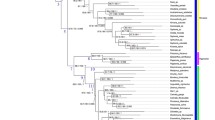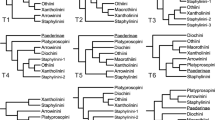Abstract
The phylogenetic relationships of the Japanese Carabinae ground beetles were analyzed by comparing 1,069 nucleotide sequences in the mitochondrial gene encoding NADH dehydrogenase subunit 5 (ND5). The ND5 phylogenetic tree revealed that the hind-wingless Carabina and the hind-wingedCalosoma/Campalita (Calosomina) diverged from the common ancestor, andCychrus (Cychrini) is the outgroup of them. Five distinct clusters (groups) can be recognized in the Carabina, i.e.,CARABUS, HEMICARABUS, LEPTOCARABUS, APOTOMOPTERUS, andPROCRUSTES/DAMASTER. The ancestors of these lineages diverged almost at the same time more than 10 Myr ago. TheCarabus cluster includes two subclusters,Carabus andOhomopterus. Two species ofCarabus examined are phylogenetically rather remote, while five species amongOhomopterus are closely related to each other. The results suggest that diversification ofCarabus started much earlier than that ofOhomopterus, presumably in the Eurasian continent, and that ofOhomopterus in the Japanese archipelago. The branching order in theLEPTOCARABUS lineage was established,Authenocarabus/Pentacarabus being their outgroup. In theDAMASTER/PROCRUSTES lineage,Procrustes is placed as the outgroup ofDamaster, with the branching order ofCoptolabrus andAcoptolabrus/Damaster. The diversification of theDamaster subspecies appeared to have occurred in the Japanese archipelago earlier thanOhomopterus, and its phylogeny reflects their geographic distribution in the archipelago rather than the morphological characters.
Similar content being viewed by others
Abbreviations
- ND5:
-
NADH dehydrogenase subunit 5
- NJ:
-
neighbor-joining
- MEGA:
-
molecular evolutionary genetics analysis
- Myr:
-
million years
References
Breuning S (1932–1937) Monographie der Gattung Carabus L Best Tab Eur Colept 104–110: 1–1610, Troppau
Brower AVZ (1994) Rapid morphological radiation and convergence among races of the butterflyHeliconius erato inferred from patterns of mitochondrial DNA evolution. Proc Natl Acad Sci USA 91:6491–6495
Clary DO, Wolstenholme DR (1985) The mitochondrial DNA molecule ofDrosophila yakuba: Nucleotide sequence, gene organization, and genetic code. J Mol Evol 22:252–271
Efron B (1982) CBMS-NSF regional conference series in applied mathematics. Monograph 38, SIAM, Philadelphia
Felsenstein J (1985) Confidence limits on phylogenies: an approach using the bootstrap. Evolution 39:783–791
Fossil Insect Res Group for Nojiri-ko Excavation, Akagi S (1986) Late Miocene to Pliocene insect fossils from the Hogi lignite formation of Ketaka-cho, Tottori Prefecture, Japan (1). Bull Osaka Mus Nat Hist 40:31–58
Garesse R (1988)Drosophila melanogaster mitochondrial DNA: gene organization and evolutionary considerations. Genetics 118:649–663
Higgins DG, Bleasby AJ, Fuchs R (1992) Clustal V: Improved software for multiple sequence alignment. Comput Appl Biosci 8:189–191
Hiura I (1971) Discovery ofApotomopterus from the Japanese Neogene (Coleoptera, Carabidae). Occ Pap Osaka Mus Nat Hist 1:45–50
Hiura I, Katsura K (1971) A new subspecies ofApotomopterus maiyasanus from the Shigaraki Mountain range, Central Kinki, Japan, with special reference to its geohistoric background (Coleoptera, Carabidae). Bull Osaka Mus Nat Hist 25:15–27
Ishikawa R (1978) A revision of the higher taxa of the subtribe Carabina (Coleoptera, Carabidae). Bull Nat Sci Mus Ser A (Zool) 4:45–68
Ishikawa R (1986) Phylogeny and subgeneric classification of the genusDamaster kollar (Coleoptera, Carabidae). Ent Papers Pres, Kurosawa, Tokyo, pp 115–130
Ishikawa R (1988) Origin and speciation of carabid-fauna. In: Sato M (ed) Beetles of Japan—their origin and speciation. Tokai Univ Press, Tokyo, pp 23–32
Ishikawa R (1989) The Japanese Carabina: geographical distribution and speciation within an archipelago (Coleoptera, Carabidae). Curr Aspects Biogeogr in W Pacific and E Asian Region, Univ Tokyo 1: 147–168
Ishikawa R (1991) The evolution ofCarabus: divergence and isolating mechanisms. Yasaka Shobo, Tokyo, pp 295
Jeannel R (1940) Les Calosomes. Mem Mus natn d'Hist nat, N Ser XIII 1:1–240
Kimura M (1980) A simple method for estimating evolutionary rate of base substitutions through comparative studies of nucleotide sequences. J Mol Evol 16:111–120
Kumar S, Tamura K, Nei M (1993) MEGA: molecular evolutionary genetics analysis version 1.01. The Pennsylvania State University, University Park, PA, p 130
Nakane T (1960) Studies in the Carabidae (Insecta, Coleoptera). Sci Rep Kyoto Pref Univ 3:17–44
Saiki RK, Gelfand DH, Stoffel S, Scharf ST, Higuchi R, Horn GT, Mullis KB, Erlich HA (1988) Primer-directed enzymatic amplification of DNA with a thermostable DNA polymerase. Science 239:487–491
Saitou N, Nei M (1987) The neighbor-joining method: a new method for reconstructing phylogenetic trees. Mol Biol Evol 4:406–425
Sanger F, Nicklen S, Coulson AR (1977) DNA sequencing with chainterminating inhibitors. Proc Natl Acad Sci USA 74:5463–5468
Su Z-H, Ohama T, Okada TS, Ishikawa R, Osawa S (1996) Geography-linked phylogeny of theDamaster ground-beetles inferred from mitochondrial ND5 gene sequences J Mol Evol 42:130–134
Author information
Authors and Affiliations
Additional information
The nucleotide sequence data reported in this paper will appear in the GSDB, DDBJ, EMBL, and NCBI nucleotide sequence databases with the accession numbers D50339-D50365
Rights and permissions
About this article
Cite this article
Su, ZH., Ohama, T., Okada, T.S. et al. Phylogenetic relationships and evolution of the Japanese Carabinae ground beetles based on mitochondrial ND5 gene sequences. J Mol Evol 42, 124–129 (1996). https://doi.org/10.1007/BF02198837
Issue Date:
DOI: https://doi.org/10.1007/BF02198837




